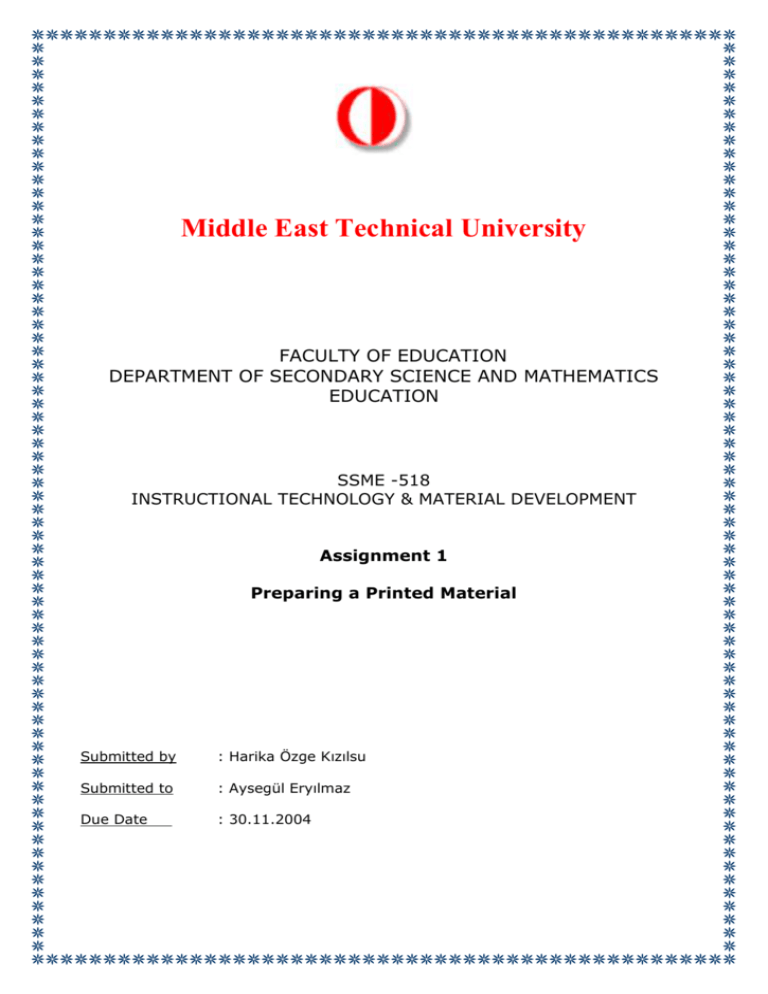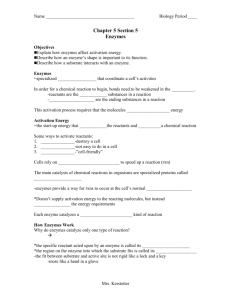Word - Middle East Technical University
advertisement

Middle East Technical University FACULTY OF EDUCATION DEPARTMENT OF SECONDARY SCIENCE AND MATHEMATICS EDUCATION SSME -518 INSTRUCTIONAL TECHNOLOGY & MATERIAL DEVELOPMENT Assignment 1 Preparing a Printed Material Submitted by : Harika Özge Kızılsu Submitted to : Aysegül Eryılmaz Due Date : 30.11.2004 Title : Enzymes Intended audience : 9 Th grade high school biology students Required entry capabilities : Students should know some chemical concepts such as chemical reaction, activation energy. They should know the previous biology subjects which have been instructed from the beginning of the term like, proteins. They should interpret the graphics. Objectives: 1. 2. 3. 4. 5. Explain the functions of enzymes in living cells. Define the terms “catalyst” and “substrate”. Describe the lock and key model of enzyme action. Define the term “activation energy”. Explain the effects of temperature, PH and enzymes and substrate concentrations on enzyme action. Outline: The importance of enzymes How enzyme work Activation energy Factors effecting enzyme activity Temperature pH Enzyme concentration Substrate concentration References: Bill Indge, Mike Boyle, AQA (A) Biology: Molecules, Cells and Systems (Collins Student Support Materials S.), 2000 p: 57-72 Bill Indge, Margaret Baker, Martin Rowland A New Introduction to Human Biology (AQA Specification A. S.), 2002 P: 68-72 http://bio.winona.msus.edu/bates/genbio/chapter4.htm 1 ENZYMES The Importance of Enzymes Enzymes are protein substances that are necessary for most of the chemical reactions that occur in living cells. There is a major difference between chemical reactions in nonliving things and the reactions in living things. Consider, for example, the burning of gasoline in an automobile engine. The gasoline vapor admitted to the engine cylinder. It is ignited by a spark. The vapor burns in a fraction of a second. In fact, the burning is so rapid that it produces a small explosion, which helps to drive the engine. Enzymes make this possible in the living cell. Enzymes enter into a chemical reaction only temporarily, speed up the rate of chemical reactions by as much as a million types and at the end of the reaction they remain unchanged. They are used again and again for the same chemical step with other molecules. A substance that brings about a reaction without being changed itself is called a catalyst. Enzymes are amazing molecules. All enzymes in a living organism are made by the cells of the organism. Each cell contains several hundred enzymes. Most of these enzymes are used within the cell in which they are made. However, some enzymes are passed out of the cell to catalyze reactions outside the cell. All the digestive enzymes that are produced in the human digestive track are of this type. For example, pepsin is an enzyme made inside the cell of glands in the stomach wall. It leaves the cell and breaks down proteins into simpler molecules. How Enzymes Work The ability of enzymes to act as catalysts depends on their shape. Each different enzyme has its own shape, with a “pocket” at a particular position. The pocket is called the active side. The substrate molecules fit the shape of the active site (Figure1). The substance that an enzyme acts upon is called its substrate. When the substrate molecule comes in contact with the active side of the enzyme, it forms a temporary union with the enzyme. This is called an enzyme-substrate complex. During this time the enzyme may break bonds within the substrate molecule. The substrate is separated into 2 smaller molecules which are called products. Substrate Enzyme Enzyme-Substrate complex + Break down of substrate Enzyme ready to repeat action Figure1: Lock and Key Model; the substrate fits exactly into the active site on the enzyme. This process can be explained like this: E + S ES P + E There is a theory to explain how the enzyme and substrate fit together at an active site. It is called the lock and key model. Just as the notched surface of a key can open only one lock, the shape of the active site of an enzyme only fits certain substrates. Thus, each enzyme can catalyze a reaction only of those substrates. They are extremely specific, generally reacting with only one substrate. Activation Energy The energy required to make substrates react is called the activation energy. This can be illustrated in the energy diagram (Figure 2). At the start of the reaction, starting substance has a certain amount of energy. In rearranging the bonds of starting substance some energy is released, so the products have less energy than the initial molecules. The minimum amount of energy needed to start the reaction is the activation energy. 1 There are two ways to get the boulder to roll down the hill. You can supply enough energy to push it to the top of the mound, where it can then roll down by itself. This is equivalent to supplying heat to start a reaction. Activation Energy Alternatively, you could dig away at the mount, reducing the energy needed to push the boulder to the top of the mound. This is equivalent to supplying an enzyme to a reaction (Figure 3). Instead of actually supplying energy, the enzyme reduces the height of the energy barrier and therefore reduces the activation energy necessary for a reaction to take place. This may not seem very impressive but the involvement of an enzyme increases the rate of the reaction by a billion times!! Factors Affecting Enzyme Action Figure2: Energy diagram of reaction. Every chemical reaction thus has an energy barrier that has to be overcome before a reaction can occur. A comparison that is often used is that of a boulder resting on top of a hill (Figure 2). Although it will naturally roll down the hill the boulder is prevented from doing so by a small mound of earth. Experiments have shown that many factors can affect the action of enzymes in living cells. These factors affect only the rate of a catalyzed reaction. The products formed by the reaction do not change. Temperature Enzymes enable cell reactions to take place at normal temperatures. Many chemical reactions that take place slowly at ordinary temperatures can be speeded up by raising temperatures. However, high temperatures can kill living cells. Enzymes speed up reactions without requiring high temperatures. Enzyme action depends on the random motion of molecules because this motion brings the substrates into contact with the enzymes. The motion increases as the temperature rises. If the temperature is low, the rate at which enzyme-substrate complexes form will be low, and the effect of the enzyme will be reduced (Figure4). Rate of reaction 36 C (optimum temperature) 0 10 20 30 40 50 60 70 Temperature Figure 3: Energy diagram illustrating that enzymes reduce the activation energy. Figure 4: The Effect of Temperature on the Rate of Enzyme Action. 2 If the temperature is reduced to near or below freezing point, enzymes are inactivated, not denatured. They will regain their function when higher temperatures are restored. pH The effectiveness of an enzyme depends on the PH of the surrounding medium. Most enzymes function efficiently over a narrow pH range. A change in pH above or below this range reduces the rate of enzyme activity considerably (Figure5). Enzyme concentration The rate of an enzyme-controlled reaction depends on how often enzyme and substrate molecules bump into each other. When there is little enzyme but a great deal of substrate, the concentration of enzyme limits the rate of the reaction. In this case, the total number of enzyme molecules is acting only a small fraction of the available substrate molecules. Adding more enzymes, therefore, increases the number of substrate molecules that can be reacting at any moment. Consequently, the reaction rate increases until a maximum rate is reached, as shown in Figure 6. The reaction rate reaches a maximum when all substrate molecules are occupied continuously. After this point, adding more enzymes will not increase the rate of the reaction. Rate of reaction At higher temperatures, the enzyme becomes more effective, because complexes are forming at a faster rate. At still higher temperatures, however, the enzyme itself starts to break down. This process is called denaturation. When the shape of the enzyme molecule changes, its active site no longer fits the substrate molecule, and it loses its effectiveness. There is a particular temperature-the optimum temperature- at which an enzyme is most effective. Optimum temperatures for enzymes in living cells are usually close to the normal cell temperature (36C). Substrate concentration constant Rate of reaction Enzym e concentration Figure 6: The Effect of Enzyme Concentration on the Rate of Enzyme Action 1 2 3 4 5 6 7 8 9 pH Figure 5: The Effect of pH on the Rate of Enzyme Action Changes in pH lead to the breaking of the enzyme bounds. The enzyme begins to lose its functional shape, particularly the shape of the active site. The enzyme is said to be denatured. The PH of the contents of the human stomach, for example, is slightly acidic. Pepsin is most effective at this pH level. The pH in the intestine is slightly basic. At this pH, the enzyme trypsin, which continues the digestion of proteins, works best. Substrate concentration The effect of substrate concentration is similar to the effect of enzyme concentration. When there is less substrate than enzyme, the amount of substrate limits the reaction rate. Thus, adding more substrate allows all the enzyme molecules to function simultaneously. Therefore, the reaction rate increases until a maximum rate is reached, as shown Figure 7. This rate is reached because all the enzyme molecules are occupied. Rate of reaction 0 Enzyme concentration constant Substrate concentration Optimum pH is the pH at which an enzyme catalyses a reaction at the maximum rate. Figure 7: The Effect of Substrate Concentration on the Rate of Enzyme Action 3 The concentrations of enzyme or substrate determine reaction rates as long as both are freely accessible to each other. However, enzyme and substrate may not be accessible to each other when, for example, a membrane or other structure separates them. In this case, the rate at which the substrate crosses the membrane or other barrier limits the rate of the reaction. The time needed for an enzyme-substrate complex to form and a reaction to occur is very short. A single enzyme molecule can catalyze thousands of substrate reactions each second. Thus, only small amounts of an enzyme need to be present in a cell at any given time. QUESTIONS 1. Enzymes are (specific/nonspecific) catalysts that the rate of chemical reaction in living system. 2. In the lock and key model, the active site is (flexible/ rigid). 5. Activation energy is: A. Energy that must be added to get a reaction started, which is recovered as the reaction proceeds. B. Difference in energy between reactants and products. C. Energy that is lost as heat. D. Free energy. 6. Which statement about enzyme catalyzed reactions is NOT true? A. Enzymes form complexes with their substrates. B. Enzymes lower the activation energy for chemical reactions. C. Many enzymes change shape slightly when substrate binds. D. Reactions occur at the "active site" of enzymes, where a precise 3D orientation of amino acids is an important feature of catalysis. 7. Explain what is meant by the key-lock model 3. What effect does an enzyme have on the rate of the reaction? 4. Is an enzyme changed by the reaction? 4






